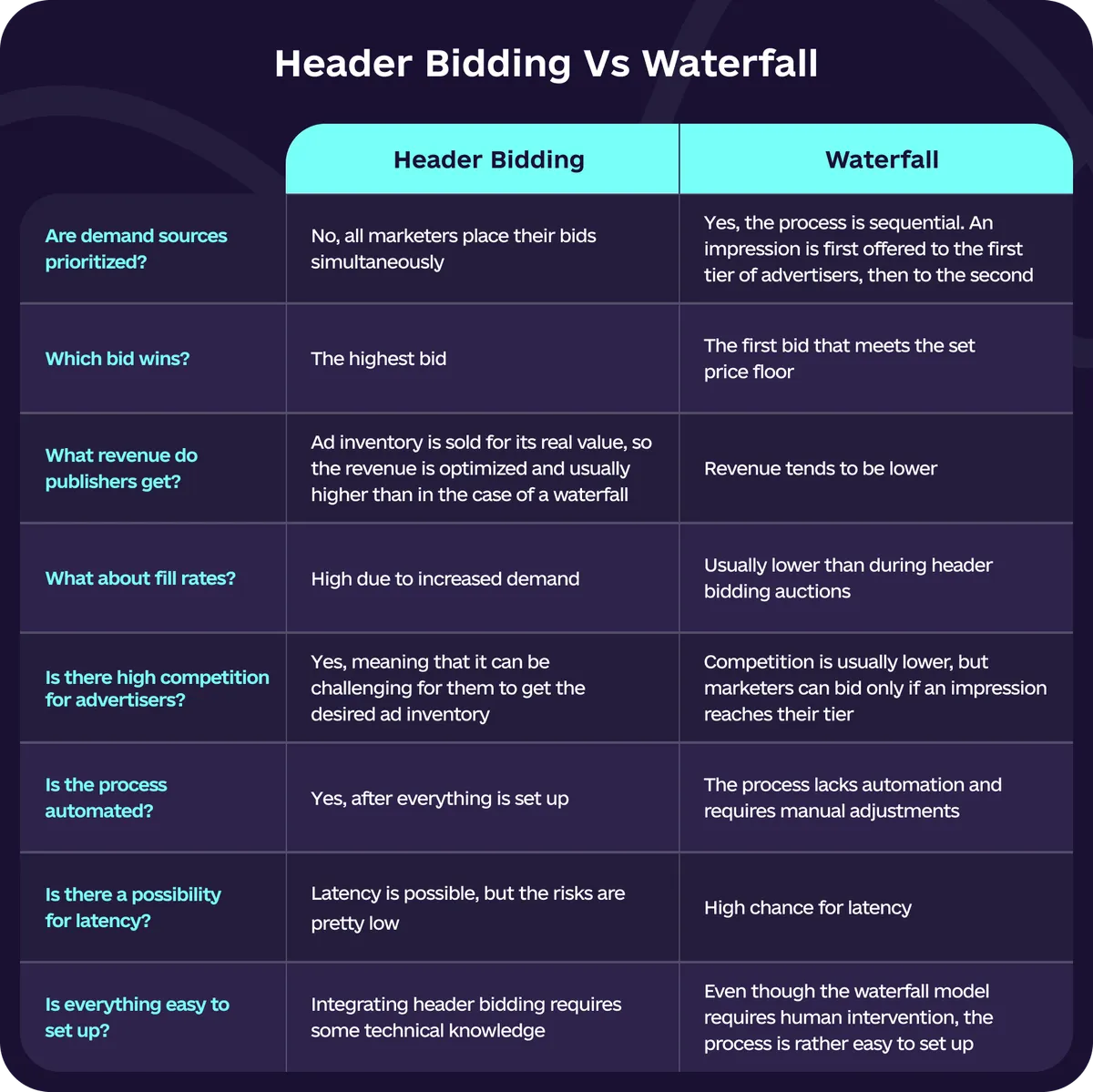Programmatic advertising comes in several models, and choosing the right one is important for both advertisers and publishers. But which approach is the most effective? We have already compared header bidding vs RTB (real-time bidding). This time, we will review header bidding vs waterfall to clarify the differences and discover which model is more beneficial.
What is the header bidding?
During a header bidding auction, ad inventory is offered to multiple demand sources at once, and the highest bid wins. This creates a more transparent environment. Advertisers benefit from equal conditions and an opportunity to access premium inventory. As for publishers, they get higher fill rates due to increased demand.
Header bidding is also known as pre-bid; however, pre-bid is rather a set of tools enabling the header bidding technology.
What is waterfall method?
As for the waterfall auction, requests are sent to ad networks or exchanges in a predetermined order. That is a sequential process, meaning that it can be challenging for some advertisers to access the desired inventory. Publishers often use this model to sell remnant inventory or make sure that the highest-paying network will be the first to access their ad space.
Note that the waterfall model is sometimes confused with real-time bidding (RTB). However, as a traditional approach, waterfall bidding simply falls under the umbrella of RTB, while RTB is also used in private marketplaces (PMPs).

How does programmatic waterfall work?
In the waterfall bidding model, ad exchanges and networks are arranged according to their historical performance. When an impression becomes available, it is first offered to the top-priority platform. If the impression is not filled, the request moves to the next exchange or network on the list. This happens until the impression gets filled or the waterfall model becomes “exhausted”.
Waterfall model advantages and disadvantages
Let’s learn more about the programmatic waterfall model by reviewing its pros and cons.
Advantages
Waterfall auctions can be useful for publishers trying to sell their remnant inventory.
Advertisers who are new to the programmatic technology usually experience less competition than during header bidding auctions.
The waterfall method is simple and easy to implement.
Publishers can prioritize their preferred networks.
Disadvantages
Non-equal conditions for advertisers and, as a result, missed opportunities.
Limited revenue opportunities for publishers since the impression may not reach an advertiser who is ready to pay the highest price.
An ad request switching between different ad exchanges can increase latency.
Unsold impressions imply lower fill rates.
The process requires more time since a publisher has to wait for each tier of demand partners to place their bids.
Requires more advanced management since a publisher needs to prioritize their demand sources.
How does header bidding work?
To enable header bidding, a publisher needs to place a piece of JavaScript code in their website’s header. After everything is set up and tested, the whole process happens very fast. In short, when a publisher’s page starts to load, the header bidding code notifies the demand partners about an available impression, and they place their bids simultaneously. The winning bid is then delivered to the ad server of a publisher and displayed to a user.
Header bidding model advantages and disadvantages
Now, let’s take a look at the pros and cons of header bidding.
Advantages
Since an impression is offered to multiple demand sources at once, advertisers bid on equal terms and can access top-quality inventory instead of waiting for an impression to reach their tier.
Higher demand for publishers and, as a result, higher fill rates.
Demand becomes more diverse, while during waterfall auctions, publishers offer their inventory only to sources they already know.
Reduced possibility of latency (although it may still happen).
The highest bid wins, which makes the auction itself fairer.
Better user experience thanks to increased diversity of demand sources – users often see exactly those ads that are relevant to them.
Disadvantages
High competition for marketers, which can be especially challenging for those who have only started to advertise programmatically.
Header bidding requires a more complex technical setup.
Sometimes, bids may be duplicated since advertisers often use several demand-side platforms to access ad inventory.
Waterfall vs header bidding comparison table
Waterfall vs. header bidding improvements seem to be obvious. Header bidding ensures greater transparency and equal conditions for all the advertisers taking part in the auction. In turn, the advertising waterfall model was effective at one time since it automated the inventory-selling process and increased the fill rate.
Nowadays, it looks outdated compared to header bidding. However, the ad waterfall approach still exists. Let’s review the differences.

Header bidding has much more advantages for both publishers and advertisers. So, why is the waterfall model still in use? The main reason for this is that publishers have better control over their demand sources. Thus, by prioritizing them, publishers first offer their inventory to their preferred advertisers.
In turn, header bidding increases demand, but publishers lack control over the types of ads that reach their ad space.
So, waterfall vs bidding via the header approach. Which option is more effective? While header bidding looks like an obvious choice, there is no universal answer to this question. Publishers need to select a model according to their needs and goals. Combining waterfall and header bidding may be an efficient solution, but the results must be analyzed thoroughly. By continuously tracking revenue, fill rates, and other metrics, publishers can fine-tune their strategies and make a data-driven decision regarding the best bidding model.
Consider Attekmi your trusted partner
Ad exchanges are key components of the programmatic ecosystem, and launching such a solution is a way to start earning on media trading. However, developing a platform from scratch is a time-consuming and usually expensive process, especially if you lack experience in the programmatic industry.
Choosing one of our Attekmi solutions enables you to bypass these obstacles. Getting AdEx Basic or AdEx Plus is a way to join the programmatic environment promptly. The supported ad formats include banner, native, video, rewarded video, audio, and pop ads, while the available traffic types are desktop, in-app, mobile web, and CTV. By applying numerous settings, you can match your demand and supply partners effectively, which will help you drive income. And if you go for a White Label Ad Exchange, you will get a solution fully customized according to your needs.
For instance, StreamKey managed to double its revenue, and you can reach the same (or even better) results.
Does Attekmi seem to be the partner you are looking for? Then let’s get in touch!
 By Anastasiia Lushyna
By Anastasiia Lushyna